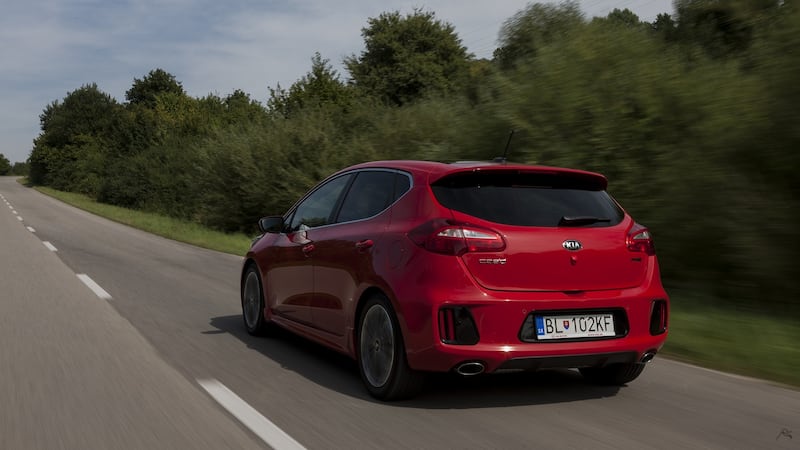If Volkswagen executives aren't already suffering under the stress and strain of managing the emissions scandal, a quick visit to a Kia dealership might add a few more grey hairs. The Korean brand now boasts some of the sharpest- looking mainstream entrants on the market and is starting to bring its engineering into line as well.
From the funky-looking Soul to the eyecatching Sportage and the under-rated Optima, the biggest surprise is that Kia doesn’t have much stronger sales.
The Cee'd is the firm's awkwardly named family hatchback and, as such, the cornerstone of its European offering. Built at the firm's Slovakian factory, it should be an also-ran when pitted against the might of the VW Golf or the Ford Focus. And in sales terms it is. Yet take a closer look at the package on offer and you start to wonder why it isn't causing sleepless nights for European car executives.

This is a facelifted version of the second-generation car launched in 2012 and you need to be guided around by a boffin to spot the subtle changes to bumpers and lights. That’s okay, however, because it looked good back in 2012 and it still does.
Added lure
There’s an added lure to the latest version: you can dress it up in the same bodykit as the topline 190bhp Cee’d GT without having to opt for the more powerful engine.
In fact, this new version boasts the latest must-have in any hatchback range: a three-cylinder petrol engine.
The recent resurrection of the small petrol engine has been remarkable. Ford stunned us with its 1-litre in the Ford Focus and since then other car firms have rushed to follow suit.
As with the wave of new small petrol powertrains, Kia’s 120bhp engine sounds nothing like the whining three-cylinders we became accustomed to in superminis of the 1990s. It might lack a little in torque and you need to work the gearbox a little more than with a larger version, but this 1-litre Kia can cruise on the motorway without any strain. And when tackling more challenging back roads, the effort you need to put in changing gear is similar to what you get with a low-revving diesel.
As the spell cast by diesel begins to be broken and Irish buyers realise that for low-mileage motorists a petrol engine is probably a better buy, the arrival of these impressive 1-litre units is very timely.
Admittedly the weak link is always going to be fuel consumption. I have struggled in the past to get close to the official consumption figures in three-cylinder petrol cars and the Kia is no different. It is claimed you can get 5l/100km (57mpg) from the car but in reality I suspect you will be doing well to get lower than 6.5l/100km (43mpg), though it depends on your driving style and the road conditions you encounter. Perhaps it was the GT bodykit, but I did tend to drive the Cee’d more like a hot hatch than it probably deserved.
Then again, that’s one of the strongest lures of this 1-litre GT-clad Cee’d. There is a 1.6-litre diesel option in the Cee’d line-up, but with a price tag of €20,650 for the basic 1-litre petrol turbo, rising to €22,550 for a GT Line, and with a motor tax €200 a year, it’s a tempting proposition for a buyer who wants the head-turning appeal of a hot hatch but without the budget-busting expense. There’s certainly an eager Irish market for this mix of sporty bodykit with a more affordable engine. The GT Line is also offered in the three-door pro_cee’d version – another Kia offering that deserves a much better moniker.
Weakness
Admittedly the hot-hatch credentials of the 1-litre Cee’d GT begin and end with the bodykit. Kia’s engineers have done an impressive job in tweaking the suspension and the car now boasts a new torque-vectoring-like system that brakes an inside front wheel in the interests of extra cornering verve. They have also overcome issues of vibration and noise that featured in earlier Cee’ds.
Yet steering remains its great weakness. In fact, it’s the Achilles’ heel of the entire Kia range, where three steering modes are offered – comfort, normal and sport – all of which feel like turning a wooden spoon in a bowl of porridge.
Comfort mode, for example, has the sort of feedback you used to get on arcade driving games in the 1980s. If the Koreans really want to be serious players on the European stage, they need to get their steering systems sorted out.
Another flaw in the Cee’d offering is arguably the cabin, where the fit and finish are impressive but the overall effect remains rather underwhelming when pitched against more tech-savvy European rivals. This is another area the Koreans should focus on if they want to move up the sales table.
These issues aside, the Cee'd certainly does surprise, even after only the most minor midlife facelift. It's much better-looking than its mechanical twin from sister brand Hyundai, the i30. The 1-litre powertrain is well-suited to the car and the GT bodykit option will lure younger buyers.
This second-generation Cee’d has also picked up several accolades for reliability and customer satisfaction, so it is working off a good foundation. It’s good enough to make it onto any hatchback buyer’s shortlist alongside the established household names.
So why isn’t the Cee’d a more common sight on Irish roads? That’s the real surprise with Kia these days and one the firm really needs to remedy.
Lowdown: Kia Cee'd 1-litre GT
Engine: 998cc three-cylinder diesel 120bhp @ 6,000rpm and 171Nm of torque @ 4,000rpm
Motor tax: €200
Fuel economy (official): 5l/100km (57mpg)
Price: €22,550 for GT Lines (starts at €20,650 for 1-litre)









